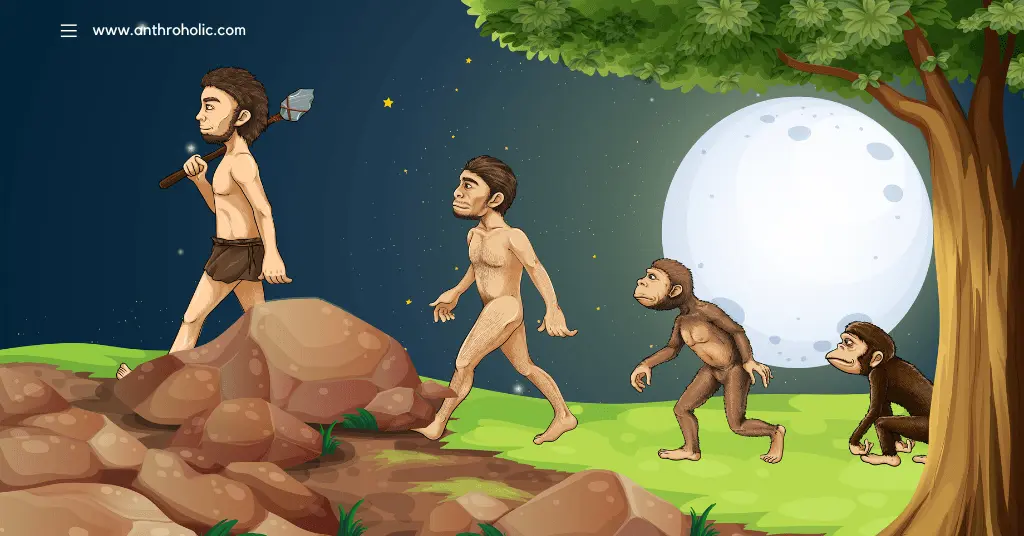AI Answer Evaluation Platform Live Now. Try Free Answer Evaluation Now
Human Evolution
Human evolution is a broad field of study that explores the biological evolution of Homo sapiens and our close ancestors, dating from the time our lineage diverged from that of chimpanzees, about six to seven million years ago. The importance of studying human evolution lies in its ability to answer fundamental questions about ourselves, such as where we come from, why we have certain physical and behavioral traits, and how we’ve adapted over time to diverse environments. Additionally, insights from human evolution can help inform our understanding of human health and disease, and can also provide a greater appreciation for our place in the natural world.

Brief Historical Overview
The study of human evolution has its roots in the 19th century, with Charles Darwin’s seminal work, “On the Origin of Species”, providing the foundational theory of evolution through natural selection. Despite initial resistance, by the late 19th century, the theory of evolution was widely accepted in scientific circles [1].
The first significant hominid fossil, dubbed “Neanderthal man,” was discovered in 1856, sparking the beginning of paleoanthropology. However, it wasn’t until the 20th century that major discoveries of early hominid fossils were made, notably by Louis Leakey and his family in East Africa, establishing Africa as the birthplace of human evolution [2].
With the advent of modern genomics in the 21st century, studies of ancient DNA have added another layer of complexity to our understanding of human evolution. Notably, these studies have revealed evidence of interbreeding between early Homo sapiens and other hominids, such as Neanderthals and Denisovans [3].
Theoretical Frameworks in Human Evolution
Darwin’s Theory of Evolution
- Darwin proposed the concept of natural selection, explaining that species evolve over successive generations through a process where traits that enhance survival and reproductive success tend to increase in frequency in a population, while less advantageous traits diminish.
- This mechanism acts on the natural variation that occurs among individuals in a population, leading over time to speciation, or the emergence of new species.
The Modern Synthesis
- The Modern Synthesis, also known as neo-Darwinism, emerged in the mid-20th century and brought together ideas from several areas of biology, including genetics, paleontology, and systematics, to create a unified framework of evolutionary biology.
- It reaffirmed Darwin’s concept of natural selection but integrated it with Mendelian genetics, providing a genetic explanation for evolution.
- The Modern Synthesis also proposed that evolution is gradual, with small genetic changes accumulating over long periods of time leading to macroevolutionary changes, a view often referred to as gradualism.
- This period marked a significant advancement in the understanding of how biological diversity arises and how the process of evolution operates at the genetic level.
The Process of Human Evolution
Role of Natural Selection
- Natural selection, first proposed by Charles Darwin, is a fundamental mechanism of evolution.
- It involves the increased survival and reproduction of individuals with traits that are advantageous in their specific environment.
- Over time, these beneficial traits become more prevalent in the population.
- For instance, the development of bipedalism in early human ancestors provided a survival advantage by freeing hands for tool use and food gathering, and thus was favored by natural selection.
Genetic Drift and Mutation
- Genetic drift refers to random changes in gene frequencies in a population due to chance.
- Over time, this process can lead to significant changes in a population and can even result in new species [4].
- Mutation, on the other hand, is the source of new genetic variation.
- It occurs when there are errors in DNA replication, leading to changes in an organism’s genetic code.
- While most mutations are neutral or harmful, occasionally, a mutation can provide a survival advantage and thus, over generations, spread through a population.
Role of Sexual Selection
- Sexual selection is a specific type of natural selection that favors traits that enhance an individual’s chance of reproduction by attracting mates or outcompeting rivals.
- Examples in human evolution include physical attributes like body size or voice pitch, as well as behavioral traits like aggression or generosity.
- Some anthropologists suggest that traits such as artistic ability and creativity, manifested in early cave paintings, may have been driven by sexual selection as a demonstration of skill to potential mates [5].
Gene Flow
- Gene flow is the transfer of genetic variation from one population to another.
- This can occur through various mechanisms, such as migration or interbreeding.
- Gene flow can introduce new genetic variation into a population, increasing its potential for evolution.
- For example, the discovery of Neanderthal DNA in modern human genomes is evidence of gene flow from Neanderthals to Homo sapiens [6].
From Primates to Homo Sapiens
Evolution of Primates
Primates, including humans, monkeys, and apes, are part of a mammalian group known as the order Primates. The order is thought to have originated more than 60 million years ago. Early primates were small, arboreal creatures that lived in tropical forests. Over time, these early primates diversified and evolved along different lineages, leading to the variety of primates we see today.
The first apes, or hominoids, appeared approximately 25 million years ago, characterized by greater flexibility in their shoulder and arm joints and an increased emphasis on vision over smell. The group that includes great apes (gorillas, bonobos, chimpanzees, and orangutans) and humans, called hominids, diverged from other apes around 15-20 million years ago. The exact sequence and timing of these divergences, however, remain subjects of ongoing research.
Hominid Family Tree
The hominid family tree or the hominin lineage began to diverge from that of chimpanzees, our closest living relatives, around six to seven million years ago. The first hominins, likely including species such as Sahelanthropus tchadensis and Orrorin tugenensis, were characterized by features such as bipedalism, despite having small brains similar to chimpanzees.
Around four million years ago, the genus Australopithecus appeared. These hominins, such as Australopithecus afarensis, had larger brains than their predecessors and were fully bipedal. The Homo genus first emerged around 2 million years ago with Homo habilis. This genus is characterized by significantly larger brains and the use of increasingly sophisticated tools.
Species like Homo erectus and Homo neanderthalensis showed increasing brain size, use of fire, and complex tool use. Finally, Homo sapiens, anatomically modern humans, appeared around 300,000 years ago, marked by an even larger brain size, sophisticated technology, and symbolic behavior.
Key Stages in Human Evolution
Last Common Ancestor of Humans and Chimpanzees (6-7 million years ago)
|——> Australopithecus (4-2 million years ago)
| |——-> Australopithecus afarensis
| |——-> Australopithecus africanus
|
|——> Homo (2 million years ago – present)
|——-> Homo habilis
|——-> Homo erectus
|——-> Homo neanderthalensis
|——-> Homo sapiens (our species)
Australopithecus: The First Hominids
The genus Australopithecus represents some of the earliest members of the hominid lineage, living between about 4 and 2 million years ago. Their traits include bipedalism, small brain sizes comparable to modern apes, and dental features indicative of a diet that included both plant and animal matter. Famous specimens include “Lucy” (Australopithecus afarensis), discovered in Ethiopia in 1974, that provided significant insight into early hominid life [7].
Homo habilis: The Handy Man
Emerging around 2.4 million years ago, Homo habilis is generally accepted as the first species of the genus Homo. This species shows a significant increase in brain size compared to Australopithecus and is associated with the earliest known stone tools, giving it the name “handy man.” This marked an important step in human evolution, as tool use allowed for a greater range of diets and behaviors [8].
Homo erectus: Upstanding Human
Homo erectus first appeared nearly 2 million years ago and is considered the first hominid species to have a truly global distribution, with fossils found in Africa, Europe, and Asia. Notable for its upright posture, Homo erectus was a successful species that persisted until about 140,000 years ago. They utilized more complex tools and were likely the first hominids to control fire [9].
Homo neanderthalensis: The Closest Relatives
Homo neanderthalensis, or Neanderthals, lived in Europe and Asia from about 400,000 to 40,000 years ago. They were the closest known relatives of modern humans, with DNA evidence indicating interbreeding between Neanderthals and the ancestors of modern humans. Neanderthals had a unique set of morphological traits, advanced tool cultures (the Mousterian), and they likely had language and complex social structures [10].
Homo sapiens: The Anatomically Modern Human
Anatomically modern humans, Homo sapiens, emerged around 300,000 years ago, characterized by a suite of physical and behavioral traits that include a high forehead, a rounded skull, and a culture that includes symbolic artifacts and widespread tool use. As the only surviving species of the genus Homo, Homo sapiens has eventually colonized almost every habitat on Earth [11].
Physical Evolution of Humans
Bipedalism and Locomotion
One of the key characteristics that distinguish hominids from other primates is bipedalism, or the ability to walk upright on two legs. The adaptation to bipedal locomotion likely emerged more than 4 million years ago, as evidenced by fossils from early hominid species such as Australopithecus afarensis. The adoption of bipedalism resulted in several anatomical changes, including alterations to the spinal column, the pelvis, and the lower limbs, which provided the ability to walk long distances and freed the hands for tool use and carrying items.
Brain Evolution
Over millions of years, hominids experienced a significant increase in brain size, which is closely linked to advancements in cognition, language, and social complexity. Early hominids had a brain size comparable to that of modern great apes. However, with the emergence of the genus Homo, brain size began to increase dramatically. This growth continued through the evolution of Homo erectus and Homo neanderthalensis, until it reached its peak in modern Homo sapiens.
Changes in Body Size and Proportions
Over time, the body size and proportions of hominids have also changed significantly. Earlier hominids, such as Australopithecus, were smaller in stature and had proportionally longer arms and shorter legs, similar to modern non-human primates. With the emergence of the Homo genus, body size increased, and limb proportions became more similar to those of modern humans – shorter arms and longer legs – likely due to changes in locomotion and climate.
Adaptations to Climate
Human evolution has also been heavily influenced by climate. For example, Homo erectus, which spread from Africa to colder regions of Europe and Asia, showed adaptations such as a larger body size and a more rounded skull, which are effective at conserving heat. Conversely, some Homo sapiens populations in hot, tropical regions evolved to have a smaller body size, which is better for dissipating heat. Skin color variation in modern humans is another clear adaptation to varying levels of sunlight across the globe.
Cultural Evolution and Human Behavior
Emergence of Tool Use
The first known stone tools, known as Oldowan tools, were produced by early members of the genus Homo, such as Homo habilis, nearly 2.6 million years ago. These simple tools marked a critical shift in hominid evolution, indicating a new way of interacting with the environment. Over time, tool use and manufacturing techniques became increasingly complex, culminating in the sophisticated blade technologies of modern humans.
Development of Language and Communication
The development of complex language is one of the defining characteristics of Homo sapiens. While the exact timing and manner of its evolution are difficult to determine, evidence suggests that the capacity for language developed alongside increasing brain size and complexity. By 50,000 years ago, modern humans were likely capable of symbolic thought and complex spoken language, as indicated by their advanced tool technologies and symbolic artifacts.
Evolution of Social Structure and Cooperation
The evolution of social structures and cooperation has been critical for human survival and success. Early hominids likely lived in small social groups, as do most primates today. Over time, as humans developed language, tools, and hunting strategies, their social groups became more complex. Evidence from anthropology and archaeology suggests that cooperation and social learning have been central to human evolution, leading to the development of diverse cultural practices, social norms, and institutions.
Art, Symbolism, and Cultural Expression
Art and symbolic behavior are considered hallmarks of modern human behavior. The earliest known examples of symbolic artifacts are beads made of ostrich eggshells and engraved patterns on ochre, dating back around 100,000 years. By 40,000 years ago, humans were creating elaborate cave paintings, musical instruments, and figurines. These cultural expressions likely served a variety of social and symbolic functions, from communication and education to spiritual practices.
Current Perspectives and Debates in Human Evolution
Multiregionalism vs. Out of Africa Hypothesis
There are two major competing theories about the evolution of modern humans: the Multiregional Continuity Model and the Out of Africa Model. The Multiregional Continuity Model proposes that modern humans evolved in different regions of the world simultaneously from local Homo erectus populations. In contrast, the Out of Africa Model asserts that modern humans evolved in Africa first, then dispersed and replaced all other hominid populations in other parts of the world [12]. While most evidence currently supports the Out of Africa Model, there is also evidence of gene flow between these early populations, leading to a more nuanced understanding of our evolutionary history.
Role of Interbreeding in Human Evolution
Recent advances in genetics have highlighted the role of interbreeding in human evolution. Evidence from the genomes of modern humans reveals traces of genetic material from other hominids like Neanderthals and Denisovans, suggesting that our ancestors interbred with these species when they encountered each other. This interbreeding may have had important implications for human evolution, such as conferring adaptive advantages to certain environments or diseases [13].
The Future of Human Evolution
Predicting the future of human evolution is a topic of much debate among scientists. Some suggest that cultural and technological evolution have essentially “halted” biological evolution, as medical and technological advancements allow individuals to survive and reproduce regardless of their genetic fitness. Others argue that human evolution continues to occur, driven by factors such as population growth, globalization, and the evolution of pathogens. Furthermore, emerging technologies like genetic engineering could have unprecedented impacts on our evolutionary trajectory.
References:
1. Darwin, C. (1859). On the Origin of Species. London: John Murray. http://darwin-online.org.uk/converted/pdf/1861_OriginNY_F382.pdf
2. Leakey, L. (1960). Adam’s Ancestors: The Evolution of Man and His Culture. Harper.
3. Reich, D. (2018). Who We Are and How We Got Here: Ancient DNA and the New Science of the Human Past. Pantheon Books.
4. Kimura, M. (1983). The Neutral Theory of Molecular Evolution. Cambridge University Press.
5. Miller, G. (2000). The Mating Mind: How Sexual Choice Shaped the Evolution of Human Nature. Doubleday.
6. Green, R.E., et al. (2010). A draft sequence of the Neandertal genome. Science, 328(5979), 710-722.
7. Johanson, D.C., & Taieb, M. (1976). Plio-Pleistocene hominid discoveries in Hadar, Ethiopia. Nature, 260(5550), 293-297.
8. Leakey, L.S.B. (1964). A new species of the genus Homo from Olduvai Gorge. Nature, 202(4927), 7-9.
9. Antón, S.C. (2003). Natural history of Homo erectus. Yearbook of Physical Anthropology, 46, 126-170.
10. Green, R.E., et al. (2010). A draft sequence of the Neandertal genome. Science, 328(5979), 710-722.
11. Hublin, J.J., et al. (2017). New fossils from Jebel Irhoud, Morocco and the pan-African origin of Homo sapiens. Nature, 546, 289-292.
12. Stringer, C., & Andrews, P. (1988). Genetic and fossil evidence for the origin of modern humans. Science, 239(4845), 1263-1268.
13. Green, R.E., et al. (2010). A draft sequence of the Neandertal genome. Science, 328(5979), 710-722.




